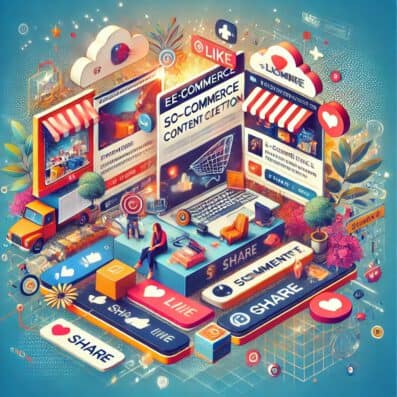In the rapidly evolving world of ecommerce, staying updated with industry jargon is crucial.
Whether you’re a budding entrepreneur, an established online retailer, or a digital marketer, understanding these terms can help you make informed decisions, optimize your business strategies, and communicate more effectively with stakeholders.
This comprehensive listicle breaks down 25 essential ecommerce terms, categorized for beginners, intermediates, and advanced users, to enhance your ecommerce vocabulary and expertise.
Essential Ecommerce Terms for Beginners
1. Ecommerce
Definition: Electronic commerce, or ecommerce, refers to the buying and selling of goods or services using the Internet.
Example: Amazon is one of the largest ecommerce platforms in the world.
2. Shopping Cart
Definition: A software application that allows customers to select products for purchase.
Example: Shopify offers various shopping cart solutions for businesses of all sizes.
3. Checkout
Definition: The process during which a customer finalizes their purchase, enters payment information, and completes the transaction.
Tip: Simplify your checkout process to reduce cart abandonment rates.
4. Payment Gateway
Definition: A service that authorizes and processes payments for online businesses.
Example: PayPal and Stripe are popular payment gateways.
5. Merchant Account
Definition: A type of bank account that allows businesses to accept payments by credit and debit cards.
Tip: Ensure your merchant account provider offers robust fraud detection features.
Intermediate Ecommerce Terms Explained
6. SEO (Search Engine Optimization)
Definition: The practice of optimizing your website to rank higher in search engine results.
Example: Using relevant keywords in your product descriptions can improve your SEO.
7. Conversion Rate
Definition: The percentage of visitors to your website who complete a desired action, such as making a purchase.
Tip: A/B testing different website elements can help improve your conversion rate.
8. Bounce Rate
Definition: The proportion of visitors who exit your website after viewing just a single page.
Example: Elevated bounce rates might suggest that your landing page lacks sufficient engagement.
9. PPC (Pay-Per-Click)
Definition: An online advertising model where advertisers pay each time a user clicks on one of their ads.
Example: Google Ads is a popular platform for PPC campaigns.
10. Affiliate Marketing
Definition: A performance-based marketing strategy where a business rewards affiliates for driving traffic or sales through their referrals.
Tip: Choose affiliates whose audience aligns with your target market for better results.
Advanced Ecommerce Terms and Definitions
11. LTV (Lifetime Value)
Definition: A prediction of the net profit attributed to the entire future relationship with a customer.
Tip: Focus on improving customer retention to increase LTV.
12. CAC (Customer Acquisition Cost)
Definition: The cost associated with acquiring a new customer.
Example: Combine your marketing and sales expenses, then divide by the number of new customers acquired.
13. ROAS (Return on Ad Spend)
Definition: A metric that measures the revenue generated per dollar spent on advertising.
Tip: Aim for a ROAS of 4 or higher to ensure profitability.
14. Inventory Turnover
Definition: A measure of how many times inventory is sold and replaced over a period.
Example: High inventory turnover indicates strong sales and effective inventory management.
15. Dropshipping
Definition: A retail fulfillment method where a store doesn’t keep the products it sells in stock. Instead, it purchases the item from a third party and ships it directly to the customer.
Tip: Vet your suppliers carefully to ensure product quality and reliability.
Common Misconceptions in Ecommerce Language
16. SSL (Secure Sockets Layer)
Misconception: SSL and HTTPS are often used interchangeably.
Clarification: SSL is the protocol that encrypts data between a browser and server, while HTTPS is the secure version of HTTP that uses SSL.
17. B2B vs. B2C
Misconception: B2B (Business-to-Business) and B2C (Business-to-Consumer) marketing strategies are the same.
Clarification: B2B marketing often involves longer sales cycles and focuses on relationships, while B2C is typically faster-paced and product-centric.
18. Omnichannel vs. Multichannel
Misconception: These terms are synonymous.
Clarification: Omnichannel integrates all channels to provide a seamless customer experience, while multichannel refers to using multiple, but not necessarily integrated, channels.
19. Free Shipping
Misconception: Offering free shipping will always increase sales.
Clarification: While free shipping can boost sales, it’s essential to analyze if it impacts your profit margins.
20. User Experience (UX)
Misconception: UX design is only about aesthetics.
Clarification: UX encompasses usability, efficiency, and satisfaction in addition to visual design.
The Future of Ecommerce: Emerging Terms
21. Headless Commerce
Definition: A separation of the front-end and back-end of an ecommerce application, allowing for more flexibility and customization.
Example: BigCommerce offers headless commerce solutions for growing businesses.
22. Voice Commerce
Definition: The use of voice recognition technology to make purchases online.
Tip: Optimize your ecommerce site for voice search to stay ahead of this trend.
23. AR (Augmented Reality) Shopping
Definition: Technology that superimposes a computer-generated image on a user’s view of the real world, enhancing the shopping experience.
Example: IKEA’s app allows customers to see how furniture will look in their homes.
24. Blockchain
Definition: A decentralized digital ledger that records transactions across multiple computers.
Example: Blockchain can enhance supply chain transparency and security in ecommerce.
25. AI-Powered Personalization
Definition: Using artificial intelligence to deliver personalized shopping experiences.
Tip: Implement AI tools to offer product recommendations based on customer behavior.
Conclusion and Recap
Understanding ecommerce terminology is vital for anyone looking to thrive in the online retail space. By familiarizing yourself with these terms, from basic concepts to advanced strategies, you’re better equipped to optimize your business and stay competitive.
Read our review on the best ecommerce platformsBenjamin Shemesh is an ecommerce enthusiast and a digital marketing expert.
He loves surfing the ocean
